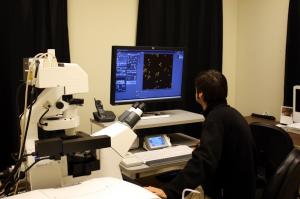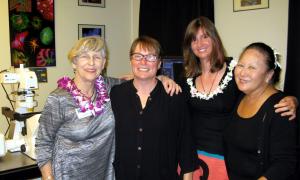New confocal microscope unveiled by the Hawai'i Institute of Marine Biology
University of Hawaiʻi at MānoaContact:
Tara L. Hicks Johnson, (808) 956-3151
Outreach Specialist, School of Ocean and Earth Sciences and Technology
Outreach Specialist, School of Ocean and Earth Sciences and Technology
Posted: Apr 5, 2011
The Hawaiʻi Institute of Marine Biology (HIMB) at the University of Hawaiʻi at Mānoa unveiled a new instrument to examine biological samples on Thursday, March 31, a Modular Laser Scanning (Confocal) Microscope. The microscope has the potential to provide groundbreaking research in marine biology, and is a powerful technique for looking at the structure and morphology of not only coral, but also the marine microorganisms that interact with them.
The microscope will be one of the few in the United States that is able to study live samples, and is unique in that it will be housed in a laboratory next to living coral reef in Kaneohe Bay. The microscope is a gift from Pam Omidyar, who herself has a background in plant molecular genetics and wanted to provide the institute with the tools needed to carry out this important research.
A confocal microscope allows researchers to investigate and construct two and three-dimensional pictures of cells, tissues and microorganisms by imaging fluorescence. This particular microscope can image live as well as fixed (dead) biological matter and is fitted with a stage that can vary temperature and carbon dioxide levels. Using fluorescent dyes that label specific parts of cells or tissues, or particular types of microorganisms, researchers can visualize where these are in cells and tissues, how they change in living tissues over time under different environmental conditions, as well as identify when specific molecules or functions are active in the tissues and cells. “Having a live imaging confocal microscope so close to a living coral reef allows the basic biology of corals to be dynamically imaged in a way that has never been done before,” says Ruth Gates, an associate researcher at HIMB and director of the Gates Lab where the new microscope is housed. “This will facilitate the rapid acquisition of knowledge for a group of animals that are the building blocks of tropical marine coastal ecosystems globally.”
Interactions between corals and microorganisms will be explored under a variety of conditions to address questions relating to coral health and disease in the context of climate change and pollution. “Coral reefs around the world are declining at an alarming rate,” adds Gates. “This is an issue that needs to be addressed now, and we are ideally situated at HIMB to address this problem.”
The microscope produces time-series images, to see how things form, how they develop, and how proteins move within cells. “The microscope allows us to look inside a specimen, without having to destroy it,” says Christine Farrar, a marine biologist at HIMB who will be managing the microscope.
The laboratory also plans to bring the microscope online, so that researchers from institutions all over the world can utilize it. “Using the Internet, we can connect remote classrooms and under-resourced institutions to our lab and share the educational and research benefit of this microscope with school children, undergraduates, and biologists. We are thrilled to have the opportunity to extend this gift to others, and demonstrate how cutting edge technologies can be used to inform important scientific questions,” added Gates. “We are particularly interested in servicing coral researchers in other Pacific Island locations in this way.”
UH Mānoa Chancellor Virginia Hinshaw said, “This microscope will enable us to learn how climate change and increases in CO2 saturation of our oceans are affecting our marine ecosystems – knowledge that’s crucial to helping our world communities develop more sustainable living practices.”
For more information about the confocal microscope and the Gates Lab at the Hawaiʻi Institute of Marine Biology, see http://www2.hawaii.edu/~rgates/Gates_Lab_Website/Gates_Lab.html
For more information, visit: http://www.soest.hawaii.edu/soest_web/soest.press-release.htm



